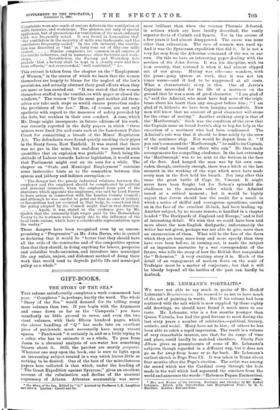MR. LEHMANN'S PORTRAITS.* WE were not able to say much
in praise of Mr. Rudolf Lehmann's Reminiscences. He seemed to us not to have much of the art of painting in words. But if his volume bad been scattered with the salt which is now supplied by these eighty odd drawings, we should have found it much more to our taste. Mr. Lehmann, who is a few months younger than Queen Victoria, has had the good fortune to meet during the last sixty years a number of celebrities,—political, literary, artistic, and social. Many have sat to him ; of others be has been able to catch a rapid impression. The result is a volume of very remarkable interest, one that, for its range of time and place, could hardly be matched elsewhere. Vanity Fair Album gives us presentments of some of Mr. Lehmann's subjects, though regarded in a different way, but it does not go so far away from home or so far back. Mr. Lehmann's earliest sketch is Pope Pius IX. It was taken in Rome about four months after the Pope's election. The artist was among the crowd which saw the Cardinal creep through the hole made in the wall which had separated the conclave from the world and announce the words': " Habemus Papam Eminentissi-
• Men and Women of the Century. Portraits and Sketches by Mr. Tindal! Lehmann. Edited, with Introduction and Biographical Note', by H. C. Marillier. London: Bell and Sons.
mum Cardinalem Maetai Ferretti, qui sibi nomen elegit Pius Nonns." The face is curiously insignificant when we come to compare it with the portrait of later years. It was somewhat disfigured by facial paralysis, which did not, however, hinder the Pope from reaching a good old age. Among the earlier portraits are the Crown Prince Frederick (1854), somewhat stiff and meaningless, and the two Brownings (1858-59). That of Elizabeth Barrett Browning is the sketch of a face shadowed by curls, which must be familiar to all readers of her poems ; that of the poet himself is somewhat disappointing, if one expects something characteristic. Nor is the later sketch (1875) very different from any " Portrait of a Gentleman " that we may see on the Academy walls. But then Browning was not commonly impressive outside his books. Of other celebrities of literature we would select as especially noteworthy. Robert Chambers, a face with solid force and just a touch of humour ; Huxley—the artist had special difficulties with this drawing —with something of a scornful touch in the lips ; Alexander von Humboldt, who has something of the look of Sir Walter Scott ; and Mommsen, an early portrait (1857). The Tenny- son sketch has more of what we may call the conventional look of a poet about it than is to be seen in the best portraits. Generally we may say that there are two styles to be seen in the collection, and that the less studied is the more effective, witness the excellent " Duke of Cambridge." Mr. Marillier supplies an introduction, in which various illustrative quota- tions from the Reminiscences are given. But why the story of Thorwaldsen, who, to our great regret, does not appear in the department of "Painting and Sculpture" P The "Biographical Notes" are for the most part wisely con- fined to dates and other facts. When Mr. Marillier wanders into criticism he is not peculiarly happy. It is a little sur- prising to be told that Mrs. Humphry Ward " fails as a novelist." It is, perhaps, vulgar to take the money value of her work, and even the multitude of her readers, into con- sideration. Still, one cannot help thinking that even partially to fail in this fashion would be supportable.























































 Previous page
Previous page